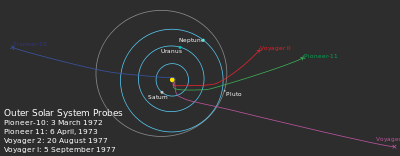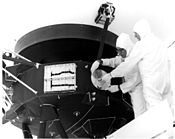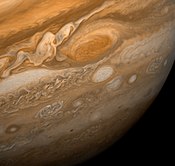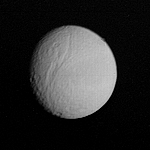Voyager 1
The Voyager 1 spacecraft is a 722-kilogram (1,592 lb) robotic American space probe launched by NASA on September 5, 1977, to study the outer Solar System and eventually interstellar space. Operating for 47 years and 9 days as of today (15 September 2024), the spacecraft receives routine commands and transmits data back to the Deep Space Network. It is the first probe to leave the Solar System and is the farthest man made object from Earth.
Being a part of the Voyager program with its sister craft Voyager 2, the spacecraft is currently in extended mission, tasked with locating and studying the boundaries of the Solar System, including the Kuiper belt, the heliosphere and interstellar space. The primary mission ended November 20, 1980, after encountering the Jovian system in 1979 and the Saturnian system in 1980.[1] It was the first probe to provide detailed images of the two largest planets and their moons.
Mission background
History
Conceived in the 1960s, a Grand Tour proposal to study the outer planets prompted NASA to begin work on a mission in the early 1970s. The development of the interplanetary probes coincided with an alignment of the planets, making possible a mission to the outer Solar System by taking advantage of the then-new technique, gravity assist.
Utilizing gravity assists would enable a single probe to visit the four gas giants (Jupiter, Saturn, Uranus, and Neptune) while requiring a minimal amount of propellant and a shorter transit duration between planets. Originally, Voyager 1 was planned as Mariner 11 of the Mariner program however, due to congressional budget cuts, the mission was scaled back to be a flyby of Jupiter and Saturn, and renamed the Mariner Jupiter-Saturn probes. As the program progressed, the name was later changed to Voyager as the probe designs began to differ greatly from previous Mariner missions.[2]
Golden record

Each Voyager space probe carries a gold-plated audio-visual disc in the event that either spacecraft is ever found by intelligent life-forms from other planetary systems. The discs carry photos of the Earth and its lifeforms, a range of scientific information, spoken greetings from people (e.g. the Secretary-General of the United Nations and the President of the United States, and the children of the Planet Earth) and a medley, "Sounds of Earth", that includes the sounds of whales, a baby crying, waves breaking on a shore, and a collection of Earth music, including works by Mozart and Chuck Berry's "Jonny B. Goode".
Spacecraft design
Constructed by the Jet Propulsion Laboratory, Voyager 1 included 16 hydrazine thrusters, three-axis stabilization gyroscopes and celestial referencing instruments (sun sensor/Canopus Star Tracker) to maintain pointing of the high-gain antenna toward Earth. Collectively these instruments are part of the Attitude and Articulation Control Subsystem (AACS) along with redundant units of most instruments and 8 backup thrusters. The spacecraft also included 11 scientific instruments to study celestial objects as it traveled through space.[3]
Communications
- Built with the intent for eventual interstellar travel, Voyager 1 included a large, 3.7-meter parabolic, high-gain antenna (see diagram) to transceive data with the Deep Space Network on Earth. Communications are conducted over the S-band (13 cm wavelength) and X-band (3.6 cm wavelength) providing bandwidth as high as 115.2 kilobits per second. When the spacecraft is unable to communicate with Earth, the Digital Tape Recorder (DTR) is able to record up to 62,500-kilobytes of data to later transmit when communication is reestablished.[3]
Power

- The spacecraft was built with 3 Multihundred-Watt radioisotope thermoelectric generators (MHW RTG). Each RTG includes 24 pressed plutonium oxide spheres and provide enough heat to generate approximately 157 Watts of power at launch. Collectively, the RTGs supply the spacecraft with 470 watts at launch and will allow operations to continue until at least 2025.[3][4] (see diagram 1, 2)
Scientific instruments
| Expand | ||||||||||||||||||||||||||||||||||||||||||||||||||||||||||||||||||||||||||||||||||||||||||||||||||||||||||||||||||||||||||||||||
|---|---|---|---|---|---|---|---|---|---|---|---|---|---|---|---|---|---|---|---|---|---|---|---|---|---|---|---|---|---|---|---|---|---|---|---|---|---|---|---|---|---|---|---|---|---|---|---|---|---|---|---|---|---|---|---|---|---|---|---|---|---|---|---|---|---|---|---|---|---|---|---|---|---|---|---|---|---|---|---|---|---|---|---|---|---|---|---|---|---|---|---|---|---|---|---|---|---|---|---|---|---|---|---|---|---|---|---|---|---|---|---|---|---|---|---|---|---|---|---|---|---|---|---|---|---|---|---|---|
| ||||||||||||||||||||||||||||||||||||||||||||||||||||||||||||||||||||||||||||||||||||||||||||||||||||||||||||||||||||||||||||||||
For more details on the Voyager space probes' identical instrument packages, see the separate article on the overall Voyager Program.
-
Voyager spacecraft diagram
-
Voyager 1 in a space simulator chamber.
-
Gold-Plated Record is attached to Voyager 1
![]() Media related to the Voyager spacecraft at Wikimedia Commons
Media related to the Voyager spacecraft at Wikimedia Commons
Mission profile
| Timeline of travel | ||||||||||||||||||||||||||||||||||||||||||||||||||||||||||||||||||||||||||||||
|---|---|---|---|---|---|---|---|---|---|---|---|---|---|---|---|---|---|---|---|---|---|---|---|---|---|---|---|---|---|---|---|---|---|---|---|---|---|---|---|---|---|---|---|---|---|---|---|---|---|---|---|---|---|---|---|---|---|---|---|---|---|---|---|---|---|---|---|---|---|---|---|---|---|---|---|---|---|---|
| ||||||||||||||||||||||||||||||||||||||||||||||||||||||||||||||||||||||||||||||
Launch and trajectory
The Voyager 1 probe was launched on September 5, 1977, by the National Aeronautics and Space Administration from Space Launch Complex 41 at Cape Canaveral, Florida, aboard a Titan IIIE/Centaur launch vehicle. Two weeks prior, the twin Voyager 2 probe had been launched on August 20, 1977. Despite being launched two weeks later, Voyager 1 reached both Jupiter and Saturn sooner after being launched into a shorter trajectory.
-
Voyager 1 lifted off with a Titan IIIE/Centaur
-
Trajectory of Voyager 1 primary mission.
Encounter with Jupiter
Voyager 1 began photographing Jupiter in January 1979. Its closest approach to Jupiter was on March 5, 1979, at a distance of about 349,000 kilometers (217,000 mi) from the planet's center. Due to the greater photographic resolution allowed by a closer approach, most observations of the moons, rings, magnetic fields, and the radiation belt environment of the Jovian system were made during the 48-hour period that bracketed the closest approach. Voyager 1 finished photographing the Jovian system in April 1979.
The two Voyager space probes made a number of important discoveries about Jupiter, its satellites, its radiation belts, and its never-before-seen planetary rings. The most surprising discovery in the Jovian system was the existence of volcanic activity on the moon Io, which had not been observed either from the ground, or by Pioneer 10 or 11.
-
Europa as seen from Voyager 1 at a distance of 2.8 million km
-
Icy surface of Ganymede as photographed from 253,000 km.
-
Valhalla crater on Callisto as imaged by Voyager 1 in 1979.
-
Voyager 1 time lapse movie of Jupiter approach. Full size video here
![]() Media related to the Voyager 1 Jupiter encounter at Wikimedia Commons
Media related to the Voyager 1 Jupiter encounter at Wikimedia Commons
Encounter with Saturn
The gravitational assist trajectories at Jupiter were successfully carried out by both Voyagers, and the two spacecraft went on to visit Saturn and its system of moons and rings. Voyager 1's Saturnian flyby occurred in November 1980, with the closest approach on November 12, 1980, when the space probe came within 124,000 kilometers (77,000 mi) of Saturn's cloud-tops. The space probe's cameras detected complex structures in the rings of Saturn, and its remote sensing instruments studied the atmospheres of Saturn and its giant moon Titan.
Because Pioneer 11 had one year earlier detected a thick, gaseous atmosphere over Titan, the Voyager space probes' controllers at the Jet Propulsion Laboratory elected for Voyager 1 to make a close approach of Titan, and of necessity end its Grand Tour there. (For the continuation of the Grand Tour, see the Uranus and Neptune sections of the article on Voyager 2.)
Its trajectory with a close fly-by of Titan caused an extra gravitational deflection that sent Voyager 1 out of the plane of the ecliptic, thus ending its planetary science mission. Voyager 1 could have been commanded onto a different trajectory, whereby the gravitational slingshot effect of Saturn's mass would have steered and boosted Voyager 1 out to a fly-by of Pluto. However, this plutonian option was not exercised, because the other trajectory that led to the close fly-by of Titan was decided to have more scientific value and less risk.[9]
-
View of Saturn lit from the right. Saturn's globe casts its shadow over the rings to the left. Part of the lower hemisphere can be seen through the rings. Some of the spoke-like ring features are visible as bright patches.
-
Mimas at a range of 425,000 km from Voyager 1.
-
Tethys photographed by Voyager 1 from 1.2 million km
-
Fractured terrain on Dione.
-
Impact craters on the surface of Rhea appear similar to Earth's Moon
-
Titan's thick haze layer is shown in this enhanced Voyager 1 image.
-
orange coloured area at bottom right is separated from black space at upper left by diagonal series of blue bands
![]() Media related to the Voyager 1 Saturn encounter at Wikimedia Commons
Media related to the Voyager 1 Saturn encounter at Wikimedia Commons
Interstellar mission

On February 14, 1990, Voyager 1 took the first ever "family portrait" of our Solar System as seen from outside,[10] which includes the famous image known as "Pale blue dot". It is estimated that both Voyager craft have sufficient electrical power to operate their radio transmitters until at least 2025, which will be over 48 years after launch.
On November 17, 1998, Voyager 1 overtook Pioneer 10 as the most distant man-made object from Earth, at a distance of 69.419 AU (1.03849×1010 km). It is currently the most distant functioning space probe to receive commands and transmit information to Earth. The spacecraft's mission now is its eternal mission, to study and wander the Interstellar Medium. Scientists expect it to cross the Heliopause sometime between 2012–2015. At 17.26 km/s (10.72 mi/s)[11] it is still the fastest probe in the Solar System.[citation needed]
Provided Voyager 1 does not collide with any stellar objects, the New Horizons space probe will never pass it, despite being launched from Earth at a faster speed than either Voyager spacecraft. New Horizons is traveling at about 15 km/s, 2 km/s slower than Voyager 1, and is still slowing down. When New Horizons reaches the same distance from the sun as Voyager 1 is now, its speed will be about 13 km/s (8 mi/s).[12] The close flyby of Saturn and Titan gave Voyager 1 a massive advantage with its extra gravity assist.
| Year | End of specific capabilities as a result of the available electrical power limitations |
|---|---|
| 2007 | Termination of plasma subsystem (PLS) |
| 2008 | Power off Planetary Radio Astronomy Experiment (PRA) |
| 2010 | Terminate scan platform and Ultraviolet spectrometer (UVS) observations |
| 2015 | Termination of Data Tape Recorder (DTR) operations (limited by ability to capture 1.4 kbit/s data using a 70 m/34 m antenna array. This is the minimum rate at which the DTS can read-out data.) |
| 2016 approx | Termination of gyroscopic operations |
| 2020 | Start shutdown of science instruments (as of 2008-03-18 the order is undecided but the Low-Energy Charged Particles, Cosmic Ray Subsystem, Magnetometer, and Plasma Wave Subsystem instruments are expected to still be operating)[citation needed] |
| 2025–2030 | Can no longer power any single instrument. |
Heliopause

As Voyager 1 heads for interstellar space, its instruments continue to study the Solar System; Jet Propulsion Laboratory scientists are using the plasma wave experiments aboard Voyager 1 and 2 to look for the heliopause, the boundary at which the solar wind transitions into the interstellar medium.
Scientists at the Johns Hopkins University Applied Physics Laboratory believe that Voyager 1 entered the termination shock in February 2003.[13] Some other scientists have expressed doubt, discussed in the journal Nature of November 6, 2003.[14] In a scientific session at the American Geophysical Union meeting in New Orleans on the morning of May 25, 2005, Dr. Ed Stone presented evidence that Voyager 1 crossed the termination shock in December 2004.
The issue will not be resolved until other data becomes available, since Voyager 1's solar-wind detector ceased functioning in 1990. This failure has meant that termination shock detection must be inferred from the data from the other instruments on board.[citation needed]
However, in May 2005 a NASA press release said that consensus was that Voyager 1 was now in the heliosheath.[15] Scientists anticipate that the craft will reach the heliopause in 2015.
Voyager 1 is the farthest human-made object from Earth in the Universe, traveling away from both the Earth and the Sun at a relatively faster speed than any other probe.[16]
Current status

As of August 2, 2011, Voyager 1 is about 117.8436 astronomical units (1.762915×1010 km) from the Sun.[17] The magnitude of the Sun from Voyager 1 is −16.4, or the dimmest as seen from any of the five space probes leaving the Solar System. Radio signals traveling at the speed of light between Voyager 1 and Earth take 16.12 hours to cross the distance between the two. (To compare, Proxima Centauri, the closest star to our Sun, is about 4.2 light-years distant or 2.65×105 AU.) Voyager 1's current relative velocity to the sun is 17,060 m/s (61,400 km/h; 38,200 mph). This calculates as 3.599 AU per year, about 10% faster than Voyager 2. At this velocity, 73,600 years would pass before reaching the nearest star, Proxima Centauri, were the spacecraft traveling in the direction of that star. Voyager 1 will need about 14,000 years at its current velocity to travel one light year, therefore 40,000 years will pass before coming anywhere near other stars or planets. Voyager 1 is predicted to enter the interstellar medium between 2012–15, though some scientists say it will be in 2014. Voyager 1 is still the farthest man made object in the universe from Earth.
As of May 21, 2011, the spacecraft is at 12.44° declination and 17.163 hours right ascension, and is at an ecliptic latitude of 34.9° (the ecliptic latitude changes very slowly), placing it in the constellation Ophiuchus as observed from the Earth. NASA continues its daily tracking of Voyager 1 with its Deep Space Network. This network measures both the elevation and azimuth angles of the incoming radio waves from Voyager 1, and it also measures the distance from the Earth to Voyager 1.
Voyager 1 is not heading towards any particular star, but in about 40,000 years it will pass within 1.6 light years of the star AC+79 3888 in the constellation Camelopardalis. That star is generally moving towards our Solar System at about 119 km/s (430,000 km/h; 270,000 mph).[18]
Events
February 17, 1998, Voyager 1 became the farthest man made object from Earth, passing Pioneer 10 at 69 AU from the sun. From this day onwards to the present, Voyager 1 has been the farthest man made object from Earth, and no probe has passed its distance and there are no probes predicted to be launched in the next 20 years that will pass the probe.
December 18, 2004, Voyager 1 passed the termination shock. This marks the point where the solar wind slows to subsonic speeds. This is the unofficial date of departure from the Solar System. While the spacecraft still remains under the sun's influence, at the termination shock particles from the interstellar medium interact with solar particles, signaling that the hypothetical heliopause is not far from this point. Six years later in 2010 Voyager 1 entered an area of the heliosheath where the solar wind outward speed is 0, or flowing sideways relative to the sun. This signals that Voyager 1 is getting very close to entering the interstellar medium.
On March 31, 2006, the amateur radio operators from AMSAT in Germany tracked and received radio waves from Voyager 1 using the 20-meter (66 ft) dish at Bochum with a long integration technique. Retrieved data was checked and verified against data from the Deep Space Network station at Madrid, Spain.[19] This is believed to be the first such tracking of Voyager 1.
On December 13, 2010, it was confirmed that Voyager 1 passed the reach of the solar wind emanating from the Sun. It is suspected that solar wind at this distance turns sideways due to interstellar wind pushing against the heliosphere. Since June 2010, detection of solar wind has been consistently at zero, providing conclusive evidence of the event.[20] The meridional (north-south) speed of the solar wind, which is suspected to have increased, cannot be inferred in Voyager 1's current configuration.[citation needed] On this date, the spacecraft was approximately 17.3 billion kilometers (116 AU or 10.8 billion miles) from the Sun[21]
On March 8, 2011, Voyager 1 was commanded to change its position to detect the current direction of the solar wind. A test roll done in February confirmed the spacecraft's ability to maneuver and reorient itself. The course of the spacecraft was not changed. It rotated 70 degrees counterclockwise with respect to Earth to detect the solar wind. This was the first time the spacecraft had done any major maneuvering since the family portrait photograph of the planets was taken in 1990. The spacecraft will be maneuvered again in the coming months to further analyze the solar wind. The spacecraft after the first roll had no problem in reorienting itself with Alpha Centauri, Voyager 1's guide star, to begin sending transmissions back to Earth. This is a major milestone in the Voyager interstellar program. Voyager 2 is still detecting outward flow of solar wind but it is estimated that in the coming months or years it will experience the same conditions as Voyager 1.[22][23]
On June 15, 2011, the distance to the interstellar medium was recalculated, which is now believed to be much less than previously thought. NASA believes that Voyager 1 may cross into the space between the stars sometime in the next year or so. The Low Energy Charged Particle device on Voyager 1 has detected the outward flow of the solar wind to be at zero. This means it is flowing parallel up and down to the sun, signaling that the interstellar medium is very close. Voyager 2 still has more travel time before it reaches the interstellar medium, while scientists believed Voyager 1 will enter interstellar space "at any time".[24]
See also
References
- ^ The term "visit" is used here in the sense of "approach".
- ^ Chapter 11 "Voyager: The Grand Tour of Big Science" (sec. 268.), by Andrew,J. Butrica, found in From Engineering Science To Big Science ISBN 978-0160496400 edited by Pamela E. Mack, NASA, 1998
- ^ a b c "VOYAGER 1:Host Information". NASA. 1989. Retrieved January 2, 2011.
- ^ Furlong, Richard R.; Wahlquist, Earl J. (1999). "U.S. space missions using radioisotope power systems" (PDF). Nuclear News. 42 (4): 26–34. Retrieved January 2, 2011.
- ^ "Voyager 1 Narrow Angle Camera Description". NASA / PDS. 2003-08-26. Retrieved 2011-01-17.
{{cite web}}:|first=missing|last=(help) - ^ "Voyager 1 Wide Angle Camera Description". NASA / PDS. 2003-08-26. Retrieved 2011-01-17.
{{cite web}}:|first=missing|last=(help) - ^ "Voyager Mission Description" NASA, February 19, 1997
- ^ "Voyager 1 Full Mission Timeline" Muller, Daniel, 2010
- ^ "Voyager – Frequently Asked Questions". Voyager.jpl.nasa.gov. 1990-02-14. Retrieved 2010-09-01.
- ^ "Photo Capion". Public Information Office. Retrieved 26 August 2010.
- ^ Webb, Stephen (2002). If the universe is teeming with aliens-- where is everybody?: fifty solutions to the Fermi paradox and the problem of extraterrestrial life. Copernicus Series. Springer. p. 62. ISBN 0387955011.
- ^ "New Horizons Salutes Voyager". New Horizons. August 17, 2006. Retrieved 2009-11-03.
- ^ Kate Tobin (November 5, 2003). "Spacecraft reaches edge of solar system". CNN.com. Retrieved 2007-08-07.
- ^ L A Fisk (2003). "Planetary Science: Over the edge?". Nature. 426 (6962): 21–22. doi:10.1038/426021a. PMID 14603294.
- ^ "Voyager Enters Solar System's Final Frontier". NASA. May 24, 2005. Retrieved 2007-08-07.
- ^ "Voyager 1 Sees Solar Wind Decline; Edges Closer to Interstellar Space". NASA. 2010-12-13. Retrieved 2010-12-15.
- ^ "Where are the Voyagers?". NASA. Retrieved May 30, 2011.
- ^ "Voyager – Mission – Interstellar Mission". Voyager.jpl.nasa.gov. 2010-08-09. Retrieved 2011-03-17.
- ^ AMSAT-DL article in German; ARRL article in English
- ^ Voyager 1 Sees Solar Wind Decline
- ^ Jonathan Amos (2010-12-14). "Voyager near Solar System's edge". BBC News. Retrieved 2010-12-21.
- ^ Voyager – The Interstellar Mission
- ^ "Voyager: Still dancing 17 billion km from Earth". BBC News. 2011-03-09.
- ^ http://www.sciencedaily.com/releases/2011/06/110615141154.htm
External links
![]() Media related to Voyager 1 at Wikimedia Commons
Media related to Voyager 1 at Wikimedia Commons
- NASA Voyager website
- Voyager Spacecraft Lifetime — interstellar mission coverage.
- Voyager 1 Mission Profile by NASA's Solar System Exploration
- Voyager 1 (NSSDC Master Catalog)
- Spacecraft Escaping the Solar System — current positions and diagrams
- Weekly Mission Reports — includes information on current spacecraft state
- We Are Here: The Pale Blue Dot. A short film on The Pale Blue Dot picture taken by Voyager. Narrated by Carl Sagan.
- Heavens-above.com
- JPL Voyager Telecom Manual
- Voyager 1 Has Outdistanced the Solar Wind
























